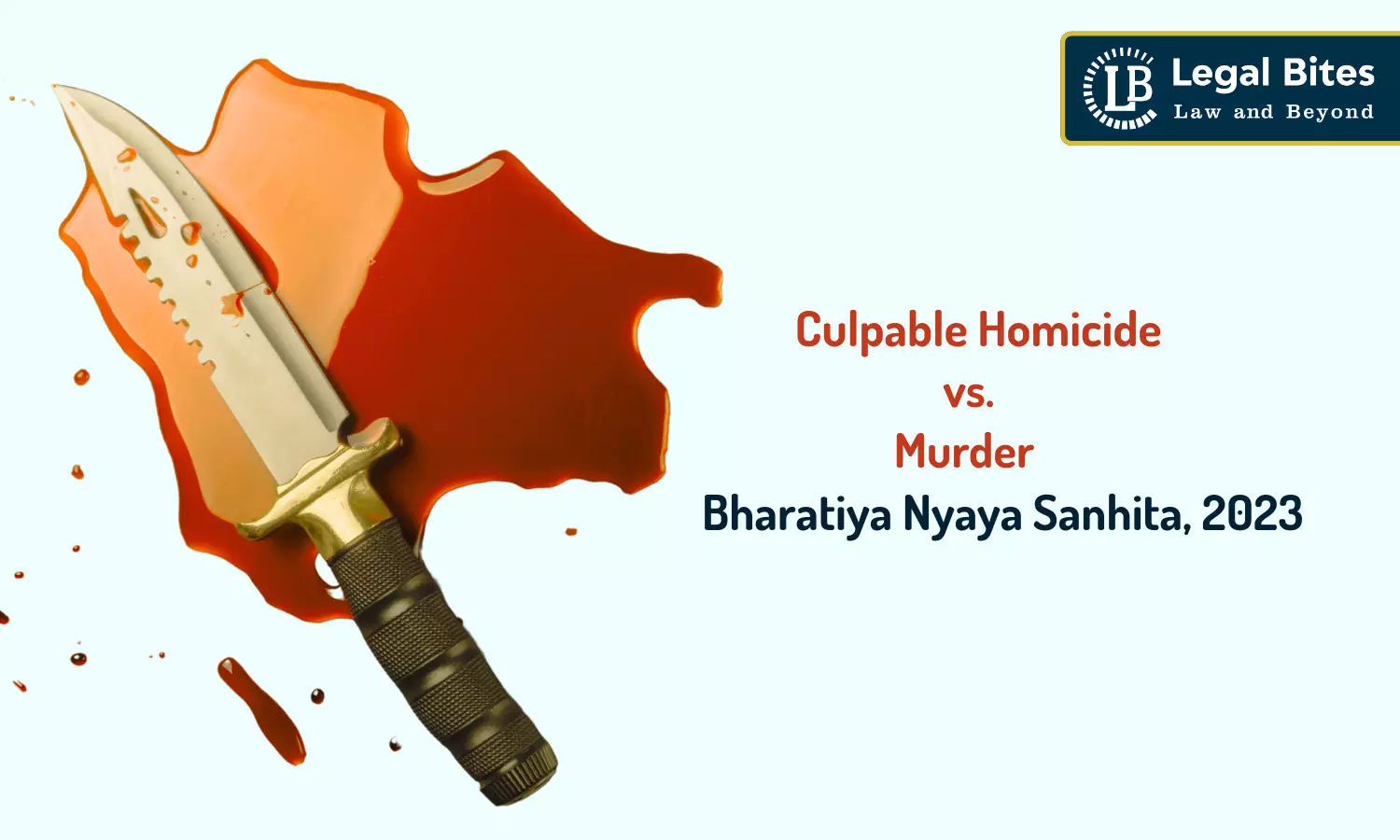Culpable Homicide vs. Murder under the Bharatiya Nyaya Sanhita, 2023
This article aims to analyse the legal provisions of culpable homicide and murder under BNS, their elements, the distinction between the two, and case laws.

The distinction between culpable homicide and murder is a nuanced yet foundational aspect of criminal jurisprudence. The Bharatiya Nyaya Sanhita, 2023 (BNS), which replaces the Indian Penal Code, 1860 (IPC), brings significant reforms to these classifications. While the underlying principles remain largely rooted in Indian legal tradition, BNS seeks to simplify, restructure, and modernise the framework.Legislative Background and Transition from IPC to BNSUnder the IPC, Sections 299 and...
The distinction between culpable homicide and murder is a nuanced yet foundational aspect of criminal jurisprudence. The Bharatiya Nyaya Sanhita, 2023 (BNS), which replaces the Indian Penal Code, 1860 (IPC), brings significant reforms to these classifications. While the underlying principles remain largely rooted in Indian legal tradition, BNS seeks to simplify, restructure, and modernise the framework.
Legislative Background and Transition from IPC to BNS
Under the IPC, Sections 299 and 300 dealt with culpable homicide and murder, respectively. With the introduction of BNS, these are now codified under:
Section 100 – Culpable Homicide
Section 101 – Murder
Section 103 – Punishment for Murder
Section 105 – Punishment for Culpable Homicide Not Amounting to Murder
The BNS streamlines the IPC's provisions without deviating from the foundational legal concepts shaped by precedent.
Definition of Culpable Homicide (Section 100)
Section 101 of BNS defines culpable homicide as follows:
“Whoever causes death by doing an act with the intention of causing death, or with the intention of causing such bodily injury as is likely to cause death, or with the knowledge that he is likely by such act to cause death, commits the offence of culpable homicide.”
Essential Ingredients:
- Causing death
- Intention to cause death
- Intention to cause bodily injury likely to cause death
- Knowledge that the act is likely to cause death
Key Points:
- The emphasis is on mens rea (mental element) and actus reus (physical act).
- Culpable homicide is a broader category within which murder exists as the gravest form.
Murder (Section 101)
According to Section 101, Culpable homicide amounts to murder if:
(a) The act is done with the intention to cause death; or
(b) The act is intended to cause an injury that the offender knows is likely to cause death; or
(c) The act is intended to cause bodily injury, and the injury is sufficient in the ordinary course of nature to cause death; or
(d) The act is so imminently dangerous that the person knows it will probably cause death or serious injury, and does it without any lawful justification.
Exceptions (Similar to IPC):
Certain situations under BNS reduce murder to culpable homicide, helping to mitigate liability based on the specific circumstances of the act.
- Grave and sudden provocation
- Exceeding right of private defence
- Public servant exceeding power in good faith
- Sudden fight without premeditation
- Consent of the deceased in certain cases
These exceptions play a crucial role in downgrading murder to culpable homicide not amounting to murder.
Punishment for Murder (Section 103)
(1) A person committing murder is punishable with death or life imprisonment, along with a fine.
(2) If five or more persons commit murder jointly on grounds like race, caste, sex, language, belief, etc., each member faces the same punishment—death or life imprisonment and fine.
Punishment for Culpable Homicide Not Amounting to Murder (Section 105)
If committed with intention to cause death or such injury likely to cause death:
Punishment:
- Imprisonment for life, or
- Imprisonment (minimum 5 years, may extend to 10 years) and
- Fine also applicable
If committed with knowledge that the act is likely to cause death (but no intention to cause death or such injury):
Punishment:
- Imprisonment up to 10 years and
- Fine
Key Differences: Culpable Homicide v. Murder
| Criteria | Culpable Homicide (Section 100) | Murder (Section 103) |
|---|---|---|
| Nature | Genus | Species |
| Intention/Knowledge | May be either | Mostly intention + specific knowledge |
| Degree of probability | Likely to cause death | Most probable consequence |
| Punishment | Imprisonment for Life or 10 years and fine | Death or life imprisonment and fine |
| Exceptions | Not applicable | Specific exceptions reduce murder to culpable homicide |
In Narasingh Challan v. State, 1997 CRILJ 2204 Orissa High Court said:
Culpable Homicide is genus, and 'murder' is the specie. All 'murder', is 'culpable homicide' but not vice versa.
Important Case Laws
[1] State of Andhra Pradesh v. Rayavarapu Punnayya & Another, (1976) 4 SCC 382
The Supreme Court clarified the distinction between culpable homicide not amounting to murder and murder under Sections 299 and 300 of the Indian Penal Code (currently Sections 100 and 101 of BNS). The accused had fatally assaulted the deceased with sticks, targeting non-vital body parts. While the High Court reduced the offence to culpable homicide under Section 304 Part II (now Section 105 BNS), the Supreme Court reversed this, holding that the injuries, though not individually fatal, were cumulatively sufficient in the ordinary course of nature to cause death.
The Court ruled that the case squarely fell under Section 300 'thirdly', reaffirming that an intention to cause death is not necessary where intentional bodily injury is sufficient to cause death in the ordinary course of nature. Thus, the conviction under Section 302 IPC (now Section 103 BNS) was restored.
[2] Reg v. Govinda, (1877)ILR 1BOM 342
This is a foundational case in Indian criminal jurisprudence. Bombay High Court distinguished between culpable homicide and murder under Sections 299 and 300 IPC (Sections 100 and 101 BNS). The accused, an 18-year-old man, had violently struck his 15-year-old wife during a quarrel, causing her death due to internal brain injuries. The Court held that while the act was intentional and likely to cause death, it was not sufficient in the ordinary course of nature to cause death and lacked the intention to kill.
Therefore, the offence was held to be culpable homicide not amounting to murder, and the sentence of death was reduced to transportation for seven years.
[3] State of Madhya Pradesh v. Ram Prasad, 1968 AIR 881
The Supreme Court held that the accused, who poured kerosene on his mistress and set her on fire, causing her death, was guilty of murder under Section 300 'Fourthly' of the Indian Penal Code (Section 101 of the Bharatiya Nyaya Sanhita). The Court reasoned that even if there was no intention to cause death, the act was so imminently dangerous and likely to cause death that it fell within the definition of murder due to the accused’s knowledge of the probable fatal outcome and absence of any justification for taking such a risk.
The judgment emphasised that callous disregard for life can amount to murder, reinforcing the scope of Section 300 (Fourthly) IPC (Section 101 BNS).
Attempt to Murder (Section 109)
- If a person does an act with the intention or knowledge that would make it murder if death were caused, they can be punished with imprisonment up to 10 years and fine.
- If the act causes hurt, the punishment may extend to life imprisonment or the same punishment as above.
Attempt to Commit Culpable Homicide (Section 110)
- If a person does an act with the intention or knowledge that would make it culpable homicide not amounting to murder if death were caused, they can be punished with up to 3 years' imprisonment, or fine, or both.
- If the act causes hurt, the punishment may extend to 7 years' imprisonment, or fine, or both
Conclusion
The Bharatiya Nyaya Sanhita retains the essential philosophical framework of the IPC while introducing structural clarity. Culpable homicide and murder, though close in definition, carry significantly different legal consequences. The law continues to evolve with judicial interpretation, and future BNS-specific jurisprudence will play a crucial role in shaping its application.

Arjun Mehta
Arjun Mehta is a legal scholar and author specializing in Criminal Law. A graduate of Banaras Hindu University (BHU), he brings academic rigor and practical insights to his writing. Through his works, Mehta illuminates the complexities of criminal jurisprudence, making legal concepts accessible to both practitioners and general readers. His contributions have established him as a respected voice in criminal law discourse.
